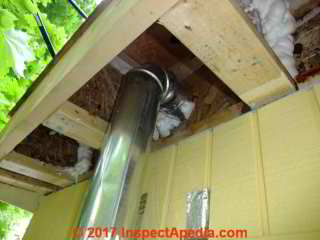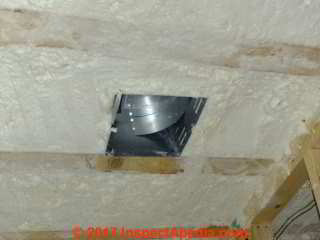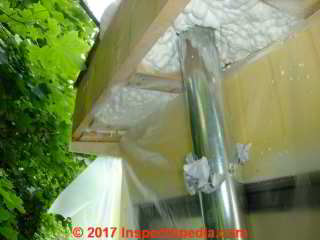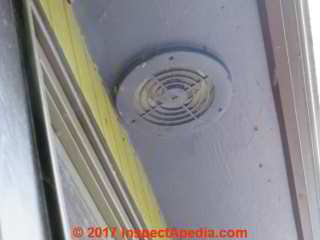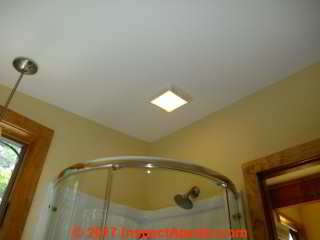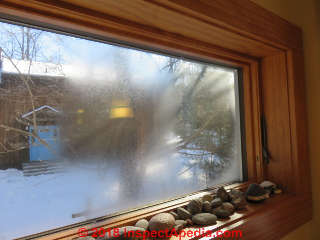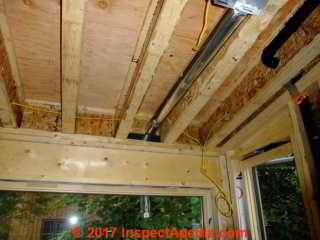 Bathroom Vent Fan Duct Down-Route
Bathroom Vent Fan Duct Down-Route
Routing a bath vent duct down in a cathedral ceiling & out through a Soffit
- POST a QUESTION or COMMENT about bathroom vent fan and fan ducting installation procedures, codes, standards
Bath vent fan duct routed down through a cathedral ceiling to the outdoors:
This article illustrates installing a bathroom exhaust fan in a cathedral ceiling over a steamy shower. The exhaust ducting is sloped downwards and terminates in a soffit.
This article series describes routing bath exhaust fan duct upwards through an attic or roof space or downwards through a floor or crawl space. In all cases the ducting needs to conduct the exchaust to the building exterior and needs to terminate in an animal-proof vent cover. Which direction is better? Up or down? It depends.
We discuss bath vent routing, insulation, slope, termination, airflow rate requirements and other specifications.
InspectAPedia tolerates no conflicts of interest. We have no relationship with advertisers, products, or services discussed at this website.
- Daniel Friedman, Publisher/Editor/Author - See WHO ARE WE?
Bath Exhaust Fan Routed Down Through Roof - Cathedral Ceiling to Soffit
These photos and notes illustrate installing a bath vent fan over a shower below a cathedral ceiling.
In this installation we routed the bath vent fan duct from the fan over the shower down through a sloped cathedral ceiling and out through the under-side of the eaves or soffit outside the building.
Our first photo, above, shows the fan housing and rough-in wiring in the ceiling. This ceiling was framed with I-joists. The "down-slope" direction of the ceiling is at the top of this photograph.
[Click to enlarge any image]
Below you can see the terminating end of this bath exhaust duct system outside, showing through the window.
We had not yet trimmed the down-pointing section of exhaust duct to length. That was done later when we were constructing the soffit enclosure and could make exactly-correct length measurements.
After the installation of the solid metal ductwork and fan housing the ceiling was insulated with spray foam insulation.
In order to be sure that we preserved the routing passage for the bath fan exhaust duct and considering that the spray insulators were going to insulate the soffit exterior as well, we taped an extension to the down-facing exhaust duct opening into position and left it there until after the insulation work was complete. [Photo below].
The bath vent fan terminates in the soffit using a self-closing plastic grille to prevent up-drafts of cold air should wind blow against the building wall when the fan is not in operation.
Below is the insulated ceiling in the bathroom over the shower before installing drywall. Y
Below our photo shows the down-extension on the bathroom exhaust vent duct that will protrude downwards through the soffit enclosure after the soffit-eaves insulation was complete.
Notice that the spray-foam insulators had taped plastic over the exterior wall to avoid splashing it with spray foam insulation over-spray. That's why my duct tape holding the temporary exhaust fan duct extension in place had been pulled off of the wall.
This bathroom exhaust vent fan installation has performed flawlessly since its installation in 2011.
A convenient feature of the down-sloping metal fan ductwork is that should there be condensation inside the exhaust duct, which is not likely given the high level of insulation around it, that moisture is directed outside through the soffit vent opening.
Above: we've installed and painted the soffit vent covering around the exhaust vent fan. Notice that this is a solid, insulated, un-vented roof eave or soffit. That's because this building uses a "hot roof" design with no roof ventilation.
Watch out: While you do not want any moist air nor condensate leaking out of your exhaust fan ducts in any structure or roof cavity, you definitely don't want it leaking into a dense-packed hot roof design where moisture can accumulte and rot the heck out of everything before it is ever noticed as a ceiling stain indoors.
The combination of using solid ducting, properly jointed (male upslope into female downslope metal duct sections with no screw penetrations, and beneath a metal roof that we installed that permits me to not worry about water nor moisture leaks into a hot roof cavity can be seen in this PHOTO of STANDING SEAM METAL ROOF [photo] during snow-guard installation.
See HOT ROOF DESIGN vs LEAK RISKS
Below is the finished ceiling around the exhaust fan / light combination over the shower.
Below: in freezing weather you can see the cloud of moist air pouring out of the exhaust fan during a steamy shower. We get some condenation on the outside of the awning window in cold weather.
Question: worries that a down-slope exhaust vent fan will soak siding or freeze-up in cold climates
(Aug 20, 2017) Bill said:
Related to installations where an attic has to be used: I'm concerned by
A.) Absence of pictures showing this done the way you recommend. partials don't tell the full story.
B.) Discussion on going out the gabled end, with it slanted in that direction, so that water goes that way introduces new concerns:
1.) To get the rise/fall/slope for a long run, on the 10' -12' mentioned above, requires about 3" at the start point, so an elbow is needed, at least two are, since you need to raise it, using a 45 or 90, then rotate down, thus there will be a lump in your run at the start the water is almost certainly vapor here, but this is a slow down point in CFM.... darned if you do, darned if you do not.
2.) Hot air and water vapor, BOTH rise. so if you think you are sloping to allow water to go out the house, this is not going to occur until that water vapor has become water again, which, as the cool air passes over it at the end of the shower IT WILL cool quickly, there is still a chance in a undersized fan situation, or unequal pressure in the home, that water vapor will sit close to the fan, and can, cool there, and water vapor could remain at the fan housing area (just really unlikely), so
3.) The water vapor very likely becomes water before making it outside especially in colder climates, and with the extra air resistance, SOOOOOOOO what does this mean AT the vent exit, near the gable?
Are you now turning on a tiny little spicket spilling water onto your siding? Behind your siding? Down an interiror wall? Well installed probably not, but still, at best, down your siding! Then when its in a winter climate, you are creating an icicle start point, freezing the door shut?
Same concerns with a roof vent,but at least with a roof vent, both the hotter air and water vapor have a chance of getting OUT fast. Still ice possibilities on the roof
Reply: down sloping exhaust fan duct + insulation + proper termination location works well to avoid ice, condensation, freeze-ups
Bill,
Thank you for taking the time to write with criticism and suggestions for better content. You're quite correct that more needs to be detailed about bathroom venting.
I agree that any installation has to worry about duct routing, slope, condensation, condensation leaks. And I agree that a long vent run across an attic to a gable end may be prohibitive. If I were doing one I'd:
- use solid metal ducting
- come up high enough off of the attic floor that I can get enough slope to the exit point
- insulate the ducts and tape joints with foil tape.
Blowing air "down" isn't easy if your fan is under-sized, but then also we don't want water from a long duct run falling back out of the ceiling.
I'm a fan of larger capacity low-sone bath fans, which of course is more expensive.
Where we have, for example, had to vent a bath fan installed close to a steamy shower through an insulated cathedral ceiling, we had a successful install: the vent is in a sloped cathedral ceiling. Its exhaust was taped aluminum vent ducts routed between rafters, down, and out through a soffit where we installed a vent terminator that protects against backdrafts.
The vent works perfectly in freezing weather - we've published photos of clouds of moist air blowing away from the building.
Indeed the vent needed enough CFM capacity to push air down and also to overcome the resistance of the length of the duct and of two 90's.
Take a look at the down-vented bathroom exhaust vent fan routed through the down-slope of a cathedral ceiling and out through the soffit at BATHROOM VENT DOWN in CATHEDRAL CEILING.
Not a drip of water spills onto the siding, no ice forms anywhere, and no water and no "spigot" of condensate falls down the siding.
I suspect that the down-slope exhaust fan we illustrate on this page (not exactly your situation) works with no moisture problems because:
- The exhaust vent fan has no trouble pushing out humid air from a steamy bath shower down the sloping run of the exhaust vent
- The exhaust fan duct is solid metal, joined in the proper direction, without leaks
- The exhaust fan ductwork is well-insulated all the way to its termination in the building soffit face.
- The occupants by habit leave the fan on for a few minutes or longer after the shower is over, not out of worry for ice formation or water on siding but to allow the fan to remove additional steam and moisture from the bathroom itself
- Tthe exhaust fan's termination is in the center of a fairly wide soffit overhang and not against nor too near the building exterior siding or wall.
Air resistance wasn't a problem in this installation. But I would be very reluctant to claim that "one size fits all" - in venting installations.
I will think more about your concern and do some research. If you'd like to send photos, sketches, or other remarks to us directly our email is at the page top or bottom CONTACT link.
...
Continue reading at BATHROOM VENT OUT THROUGH SOFFIT or select a topic from the closely-related articles below, or see the complete ARTICLE INDEX.
Or see these
Recommended Articles
- BATHROOM VENTILATION CODES SPECS - home
- BATHROOM VENTILATION DESIGN
- BATHROOM FAN ENERGY COST
- BATHROOM FAN HEAT RECOVERY
- BATHROOM VENT FAN SIZING & NOISE RATINGS
- BATHROOM FAN WIRING
- BATH KITCHEN VENT DUCT SHARING
- BATHROOM VENT AIR SUPPLY
- BATHROOM VENT CLEARANCES
- BATHROOM VENT CODES
- BATHROOM VENT DUCT LENGTHS
- BATHROOM VENT DUCT MATERIALS
- BATHROOM VENT DUCT ROUTING
- BATHROOM VENT DUCT INSULATION
- BATHROOM VENT DUCT SLOPE
- BATHROOM VENT DUCT TERMINATION
- BATHROOM VENT DUCT PROTECTION
Suggested citation for this web page
BATHROOM VENT DOWN in CATHEDRAL CEILING at InspectApedia.com - online encyclopedia of building & environmental inspection, testing, diagnosis, repair, & problem prevention advice.
Or see this
INDEX to RELATED ARTICLES: ARTICLE INDEX to BUILDING VENTILATION
Or use the SEARCH BOX found below to Ask a Question or Search InspectApedia
Ask a Question or Search InspectApedia
Try the search box just below, or if you prefer, post a question or comment in the Comments box below and we will respond promptly.
Search the InspectApedia website
Note: appearance of your Comment below may be delayed: if your comment contains an image, photograph, web link, or text that looks to the software as if it might be a web link, your posting will appear after it has been approved by a moderator. Apologies for the delay.
Only one image can be added per comment but you can post as many comments, and therefore images, as you like.
You will not receive a notification when a response to your question has been posted.
Please bookmark this page to make it easy for you to check back for our response.
IF above you see "Comment Form is loading comments..." then COMMENT BOX - countable.ca / bawkbox.com IS NOT WORKING.
In any case you are welcome to send an email directly to us at InspectApedia.com at editor@inspectApedia.com
We'll reply to you directly. Please help us help you by noting, in your email, the URL of the InspectApedia page where you wanted to comment.
Citations & References
In addition to any citations in the article above, a full list is available on request.
- "Panasonic® Ventilating Fan Installation Instructions, FV-05VQ3, FV-08VQ3, FV11VQ3, FV-15VQ3", X120-4-8189Panasonic Consumer Electronics Co., Div. of Panasonic Corp. of North America, One Panasonic Way, Seacaucus NJ 07094 & Panasonic Canada, Inc., 5770 Ambler Dr., Imssissauga, ON L4W 2T3, Website: www.panasonic.com, retrieved 4/7/14
- "Brink Renovent HR Installation and Operation Manual", Brink Climate Systems, P.O. box 11 NL-7950 AA Staphorst +31 522 46 99 44 info@brinkclimatesystems.nl www.brinkclimatesystems.nl retrieved 4/7/14 This is the installation guide for medium & large Brink Renovent HR systems.
- Mark Cramer Inspection Services Mark Cramer, Tampa Florida, Mr. Cramer is a past president of ASHI, the American Society of Home Inspectors and is a Florida home inspector and home inspection educator. Mr. Cramer serves on the ASHI Home Inspection Standards. Contact Mark Cramer at: 727-595-4211 mark@BestTampaInspector.com
- John Cranor [Website: /www.house-whisperer.com ] is an ASHI member and a home inspector (The House Whisperer) is located in Glen Allen, VA 23060. He is also a contributor to InspectApedia.com in several technical areas such as plumbing and appliances (dryer vents). Contact Mr. Cranor at 804-873-8534 or by Email: johncranor@verizon.net
- Eric Galow, Galow Homes, Lagrangeville, NY. Mr. Galow can be reached by email: ericgalow@gmail.com or by telephone: 914-474-6613. Mr. Galow specializes in residential construction including both new homes and repairs, renovations, and additions.
- Our recommended books about building & mechanical systems design, inspection, problem diagnosis, and repair, and about indoor environment and IAQ testing, diagnosis, and cleanup are at the InspectAPedia Bookstore. Also see our Book Reviews - InspectAPedia.
- In addition to citations & references found in this article, see the research citations given at the end of the related articles found at our suggested
CONTINUE READING or RECOMMENDED ARTICLES.
- Carson, Dunlop & Associates Ltd., 120 Carlton Street Suite 407, Toronto ON M5A 4K2. Tel: (416) 964-9415 1-800-268-7070 Email: info@carsondunlop.com. Alan Carson is a past president of ASHI, the American Society of Home Inspectors.
Thanks to Alan Carson and Bob Dunlop, for permission for InspectAPedia to use text excerpts from The HOME REFERENCE BOOK - the Encyclopedia of Homes and to use illustrations from The ILLUSTRATED HOME .
Carson Dunlop Associates provides extensive home inspection education and report writing material. In gratitude we provide links to tsome Carson Dunlop Associates products and services.



